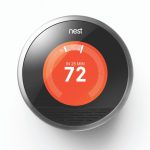
Fans Cool People, Not Rooms
You’re pretty smart to turn the A/C up a couple notches and run ceiling fans to help keep you cool in the summertime. They’re reliable, worry-free and cost a lot less to operate – just flip the switch on and start saving a bunch of money, right? Yes, but only when you’re in the room to enjoy the breeze. To get the most comfort and savings from using your fans, here are a few helpful tips:
TURN YOUR CEILING FAN ON
Of course, turning your thermostat up and running your ceiling fan (not your A/C unit’s fan) during the hot summer months will help you save energy, since the ceiling fan uses less electricity than your air conditioner. But, a lot of people confuse cooling the air in the room with cooling the people in the room.
Unlike your A/C, which cools the air, blows it into the room and lowers the temperature, your ceiling fan works by circulating the air already in the room, causing it to rush across your skin and evaporate the moisture, which makes you feel cool.
So, the fan really only cools the people in the room where it’s operating and does nothing to actually lower the temperature – or cool – the room itself.
TURN YOUR CEILING FAN OFF
Since your ceiling fan cools only you and not the room, you should always turn it off when you leave the room for more than a few minutes. There are no benefits to circulating the air in an unoccupied room, and it wastes electricity.
If you don’t use ceiling fans, get an oscillating fan for the most effective cooling. It will circulate the air around you and cover a wider area of the room (and all the people in it). But, don’t forget to unplug it when it’s not in use, to keep it from draining vampire power (when an appliance sucks power from the outlet, even if it’s turned off).
TURN YOUR FAN AROUND
Did you know your ceiling fans can also help you save electricity and keep your home more comfortable in the wintertime? Most ceiling fans are multi-directional – meaning they can either turn clockwise or counterclockwise – creating either an updraft or downdraft in the room.
By default, your fan is set up to turn counter-clockwise and push the air downward, which causes the moisture on your skin to evaporate and makes you feel cooler.
But most fans give you an option to switch the rotation to clockwise. Use this setting in the wintertime to create an updraft, which will push the warm air that’s trapped on the ceiling back down the walls and make the room feel warmer.
If you’re ever in doubt as to whether your fan is turning in the right direction, simply stand beneath it while it’s on and see if you feel the downdraft. If you don’t, try changing the direction of the blades, which is usually accomplished by flipping a small switch on the side of the fan.
Keep these helpful tips in mind and get the most function and savings out of your fans year-round. Learn more about how to save money and keep your home comfortable.




